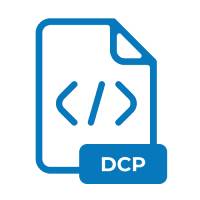.DCP File Extension

Adobe DNG Camera Profile
| Developer | Adobe Systems |
| Popularity | |
| Category | Settings Files |
| Format | .DCP |
| Cross Platform | Update Soon |
What is an DCP file?
.DCP file extension holds significant importance, particularly for professionals and enthusiasts striving for precise color rendition in their images.
This file format is associated with Adobe’s Digital Negative (DNG) Camera Profiles, offering a means to ensure consistency and accuracy in color reproduction across various devices and software platforms.
In this article, we delve into the intricacies of the .DCP file extension, exploring its origins, structure, conversion methods, and usage across different operating systems.
More Information.
Initially, Adobe DNG Camera Profiles (.DCP) were developed to accompany DNG files and provide precise color rendition tailored to specific camera models.
These profiles encapsulate information about a camera’s color response and characteristics, enabling software applications like Adobe Lightroom and Adobe Camera Raw to interpret raw image data accurately.
The primary purpose was to deliver consistent color reproduction across different cameras, thereby facilitating a seamless editing experience for photographers.
Origin Of This File.
The .DCP file extension is deeply rooted in Adobe’s endeavor to establish a universal standard for raw image files.
It emerged alongside the introduction of Adobe’s Digital Negative (DNG) format in 2004. DNG was conceived as an open standard for raw image files, aimed at addressing the myriad of proprietary raw formats generated by different camera manufacturers.
By offering a standardized format, Adobe sought to simplify raw image processing workflows and ensure long-term archival stability.
File Structure Technical Specification.
The structure of a .DCP file is characterized by its XML-based format, containing data points that define color transformations and calibrations specific to a particular camera model.
These transformations are typically derived from extensive testing and analysis conducted by Adobe’s engineers to ensure fidelity to the original scene.
The technical specifications of .DCP files encompass various parameters, including color matrices, tone curves, and hue adjustments, all of which contribute to achieving accurate color reproduction.
How to Convert the File?
Converting .DCP files involve a series of steps aimed at integrating them into a photographer’s workflow effectively.
One common method is to utilize Adobe’s software suite, including Adobe Lightroom and Adobe Camera Raw, which natively support .DCP profiles.
Users can import .DCP files into these applications and apply them to their raw images during the editing process.
Alternatively, third-party software tools exist that facilitate the conversion of .DCP files into other formats compatible with various editing platforms.
These tools often offer additional features such as batch processing and advanced customization options, catering to the diverse needs of photographers.
Advantages And Disadvantages.
One of the key advantages of .DCP files is their ability to maintain consistent color rendition across different software applications and platforms.
By utilizing standardized camera profiles, photographers can ensure that their images retain the intended color accuracy, regardless of the editing environment.
Moreover, .DCP profiles offer flexibility in fine-tuning color adjustments, allowing users to customize rendering according to their preferences.
Potential drawback of .DCP files lie in their dependency on specific camera models. While Adobe provides a vast library of camera profiles for popular models, support for less common or older cameras may be limited.
This can pose challenges for photographers using niche or vintage equipment, as they may need to resort to manual adjustments or third-party solutions to achieve desired color accuracy.
How to Open DCP?
Open In Windows
- Adobe Photoshop Lightroom: Adobe Lightroom, a widely-used photo editing software, natively supports .DCP files. Simply import the .DCP file into Lightroom and apply it to your raw images during the editing process.
- Adobe Camera Raw: If you’re using Adobe Photoshop, you can access .DCP files through Adobe Camera Raw, which integrates seamlessly with Photoshop. Open your raw image in Camera Raw and navigate to the Camera Calibration tab to apply the .DCP profile.
- Third-Party Software: Some third-party raw image processing software also support .DCP files. Programs like Capture One and DxO PhotoLab offer comprehensive editing capabilities and compatibility with .DCP profiles.
Open In Linux
- Darktable: Darktable is an open-source photography workflow application and raw developer, available for Linux and other platforms. It supports .DCP profiles, allowing Linux users to apply them to their raw images for accurate color rendering.
- RawTherapee: Another open-source raw image processing software, RawTherapee, offers advanced editing features and support for .DCP camera profiles on Linux systems.
Open In MAC
- Adobe Lightroom & Camera Raw: As with Windows, macOS users can utilize Adobe Lightroom and Adobe Camera Raw to open and apply .DCP profiles to their raw images seamlessly.
- Third-Party Software: Similar to Windows, macOS users can explore third-party raw processing software such as Capture One or DxO PhotoLab, which offer compatibility with .DCP files.
Open In Android
- Adobe Lightroom Mobile: For users on Android devices, Adobe Lightroom Mobile provides a powerful solution for editing raw images, including support for .DCP profiles. Simply import the .DCP file into Lightroom Mobile and apply it to your images.
- Third-Party Apps: While options may be more limited compared to desktop platforms, some third-party photo editing apps on Android may offer support for .DCP files. Explore the Google Play Store to find apps that cater to raw image processing and editing needs.
Open In IOS
- Adobe Lightroom Mobile: iOS users can take advantage of Adobe Lightroom Mobile, available on the App Store, to open and apply .DCP profiles to their raw images directly on their iPhones or iPads.
- Third-Party Apps: Similarly to Android, iOS users can explore third-party photo editing apps on the App Store that support .DCP files. Look for apps with raw image editing capabilities to find options compatible with .DCP profiles.












